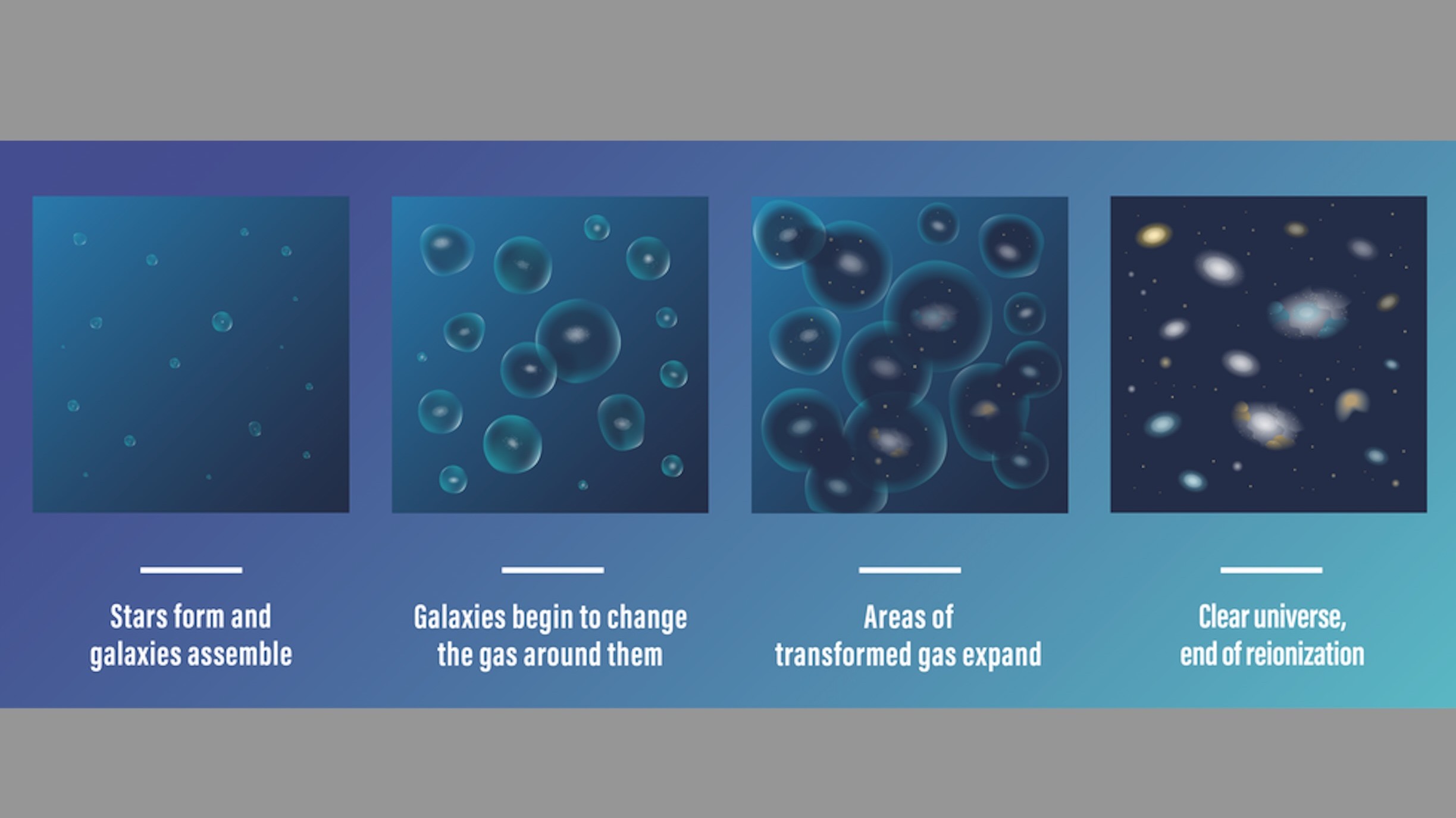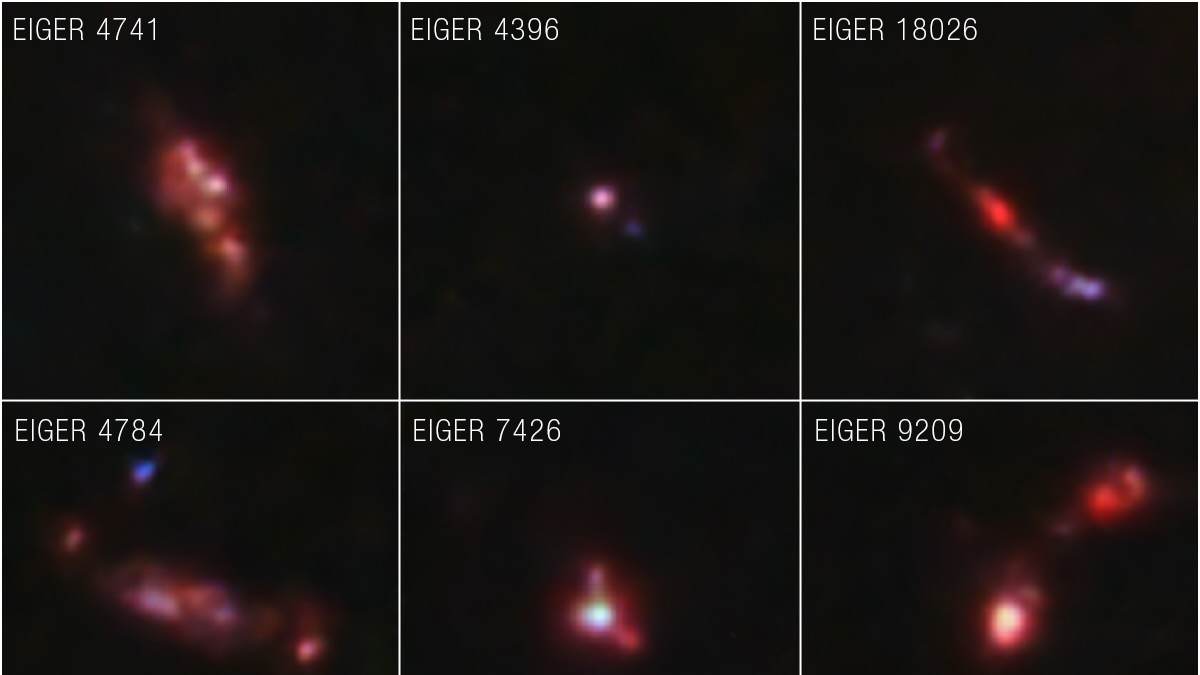James Webb Space Telescope reveals how galaxies made the early universe transparent
Once upon a time, the cosmos was opaque.

Shortly after the Big Bang, the universe was a dark and mysterious place.
And I mean really dark — the gas between stars and galaxies was opaque, so no light could shine through. As anyone who's ever looked through a telescope knows, that's no longer the case, since we can see celestial objects all throughout the universe from our vantage point here on Earth. But what caused the change in opacity?
Using observations from NASA's James Webb Space Telescope, an international team of astronomers led by Simon Lilly of ETH Zürich in Switzerland has an answer. The team looked back in time at galaxies from the end of the Era of Reionization, a dramatic period in the universe's history in which gas was heated, cooled and then reionized (given an electrical charge once again).
Related: James Webb Space Telescope (JWST) — A complete guide

Looking at those early galaxies, which existed just 900 million years after the Big Bang, the team saw that most of the gas in the universe was somewhere between opaque and transparent. But directly around the galaxies, everything was clear.
"With Webb's data, we are seeing galaxies reionize the gas around them," Daichi Kashino of Japan's Nagoya University, lead author of a new paper sharing the team's results, said in a statement.
Imagine that each of these young galaxies was surrounded by a balloon. Energy from newly forming stars reionized the gas inside that balloon. As the galaxies grew, the bubbles of reionized gas merged, creating even larger pockets of transparency. Eventually, they all combined to create a transparent universe.
Get the Space.com Newsletter
Breaking space news, the latest updates on rocket launches, skywatching events and more!
The team was able to see this phenomenon in action thanks to the illumination of a quasar, an extremely bright supermassive black hole. Turning Webb toward one particular quasar, the astronomers observed its light moving through the universe's gas, being absorbed by opaque gas in some areas and traveling through transparent gas in others.
"By illuminating gas along our line of sight, the quasar gives us extensive information about the composition and state of the gas," Anna-Christina Eilers of the Massachusetts Institute of Technology, the lead author of another one of the team's newly released papers, said in the same statement.

Next, the team will more deeply research galaxies in five other areas of the sky that all have a central quasar — shedding more light (pun intended) on the opacity of the early universe.
The team announced these results in three papers published Monday (June 12) in The Astrophysical Journal. You can find them here, here and here.
Follow Stefanie Waldek on Twitter @StefanieWaldek. Follow us on Twitter @Spacedotcom and on Facebook.
Join our Space Forums to keep talking space on the latest missions, night sky and more! And if you have a news tip, correction or comment, let us know at: community@space.com.

Space.com contributing writer Stefanie Waldek is a self-taught space nerd and aviation geek who is passionate about all things spaceflight and astronomy. With a background in travel and design journalism, as well as a Bachelor of Arts degree from New York University, she specializes in the budding space tourism industry and Earth-based astrotourism. In her free time, you can find her watching rocket launches or looking up at the stars, wondering what is out there. Learn more about her work at www.stefaniewaldek.com.
-
rod https://phys.org/news/2023-06-webb-telescope-galaxies-early-universe.html, I read this report too and note some items here.Reply
My observations, no pristine gas or metal free gas is seen in the quasar light, Lyman alpha. I also note this in the phys.org report, “What do these galaxies look like? "They are more chaotic than those in the nearby universe," explained Jorryt Matthee, also of ETH Zürich and the lead author of the team's second paper. "Webb shows they were actively forming stars and must have been shooting off many supernovae. They had quite an adventurous youth!" Along the way, Eilers used Webb's data to confirm that the black hole in the quasar at the center of this field is the most massive currently known in the early universe, weighing 10 billion times the mass of the Sun. "We still can't explain how quasars were able to grow so large so early in the history of the universe," she shared.” My note, *more chaotic*, and *shooting off many supernovae* is needed to explain the metals seen in the gas, a SMBH confirmed some 10 billion solar masses, and difficult to explain how quasars formed and grew so large, so early in the BB model for the expanding universe.
Ref - EIGER. I. A Large Sample of -emitting Galaxies at 5.3 < z < 6.9 and Direct Evidence for Local Reionization by Galaxies, https://iopscience.iop.org/article/10.3847/1538-4357/acc588, 12-June-2023.
Ref - EIGER. II. First Spectroscopic Characterization of the Young Stars and Ionized Gas Associated with Strong Hβ and Line Emission in Galaxies at z = 5–7 with JWST, https://iopscience.iop.org/article/10.3847/1538-4357/acc846, 12-June-2023.
Ref - EIGER. III. JWST/NIRCam Observations of the Ultraluminous High-redshift Quasar J0100+2802, https://iopscience.iop.org/article/10.3847/1538-4357/acd776, 12-June-2023.
My notes. Using cosmology calculators, https://lambda.gsfc.nasa.gov/toolbox/calculators.html and z=6.9, I get these values for the expanding universe in BB cosmology. Look back distance or light time = 12.936 Gyr or 12.936 billion light years from Earth. Age of universe at z = 0.786 Gyr or < 800 million years old universe after BB event. Comoving radial distance 28.647 Gly from Earth today. Space at the comoving radial distance expands 2.0215222E+00 or a bit more than 2 x c velocity using H0 = 69 km/s/Mpc. Any postulated stellar evolution along the comoving radial distance is not observable from Earth today. The gas seen still contains metals and is not pristine gas from the postulated BBN and before the CMBR is said to evolve or metal free gas that is pristine from the cosmic dark ages after the CMBR is said to form, about 380,000 years after postulated BB event that violates the conservation law of energy.









